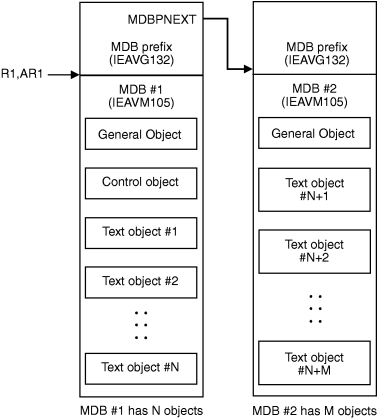The MDB is a data area that contains either a message or a DOM directed to an extended MCS console, and any information related to that message. It also contains a prefix area mapped by mapping macro IEAVG132. This area points to any subsequent MDBs for a given message. If there are no subsequent MDBs, this area contains a zero.
Messages reside in MDBs, which are put into a data space created when a program issues the MCSOPER macro to establish itself as an extended MCS console. When a message is sent to an extended MCS console, the system places the message in an MDB, where the message stays until the extended MCS console program issues the MCSOPMSG macro to locate the message.
If a DOM is directed to a previously issued message, the system creates a separate MDB for the DOM. The MDBGDOM field in the MDB identifies the MDB as a DOM MDB. The MDBDOMFL field indicates whether the console specified DOM(NORMAL) or DOM(ALL). If the console specified DOM(NORMAL), MDBGMID in the DOM MDB matches the same field in the message MDB. If the console specified DOM(ALL), the DOM field values in the control program object indicate which message or messages this DOM is to delete. A single DOM MDB can delete more than one message.

The MDB generally contains three objects, each beginning with the length and MDB type specific to each object. To locate the objects, use the address of the MDB returned by MCSOPMSG. The object type identifies the object as a general, control, or text object. Within each object is a field that contains the length of the particular object. MDBGLEN contains the length of the general object, MDBCLEN contains the length of the control program object, and MDBTLEN contains the length of the text object.
To find the first object, add the length of the header to the MDB address. The object type will tell you whether it is a general, control, or text object. To find the end of the first object, add the length of that object to the end of the header.
You can find subsequent objects by identifying the end of the previous object, and adding the length of the next one. Compare the end value to the end of the MDB length to ensure that you are still looking within the MDB.
You can find the end of the MDB by adding the total length of the MDB, which is contained in the first field of the header, to the address of the MDB.
- The general object contains information about the message or DOM. It contains a message ID, time stamp, and indication of whether the MDB holds a WTO, WTOR, or a DOM. Each MDB has one general object.
- The control program object contains information about the message or DOM that is specific to MVS™. If the message is a WTO or WTOR, the control program object contains routing codes, message level, job name, and other message information. If the MDB contains a DOM, the control program object contains the ASID, jobstep TCB, or system ID that deleted the message. Each MDB has one control program object.
- The text object contains the message text, which is variable in length. Each line of a message is represented by one text object. If the MDB cannot hold all text objects for a specific message, any remaining text objects will be placed in one or more additional MDBs. The MDB prefix points to the next MDB. That MDB will contain only the general object and the remaining text objects. If multiple messages are delivered, each message will be placed in a separate MDB, which must be retrieved via MCSOPMSG. These separate MDBs may, as before, consist of one MDB, or several MDBs chained together.
The general objects and the control program objects appear anywhere in the first MDB, but text objects are sorted in order within and among MDBs.
If the system sends a DOM to an extended MCS console, the MDB contains only two objects: the general object and the control program object.